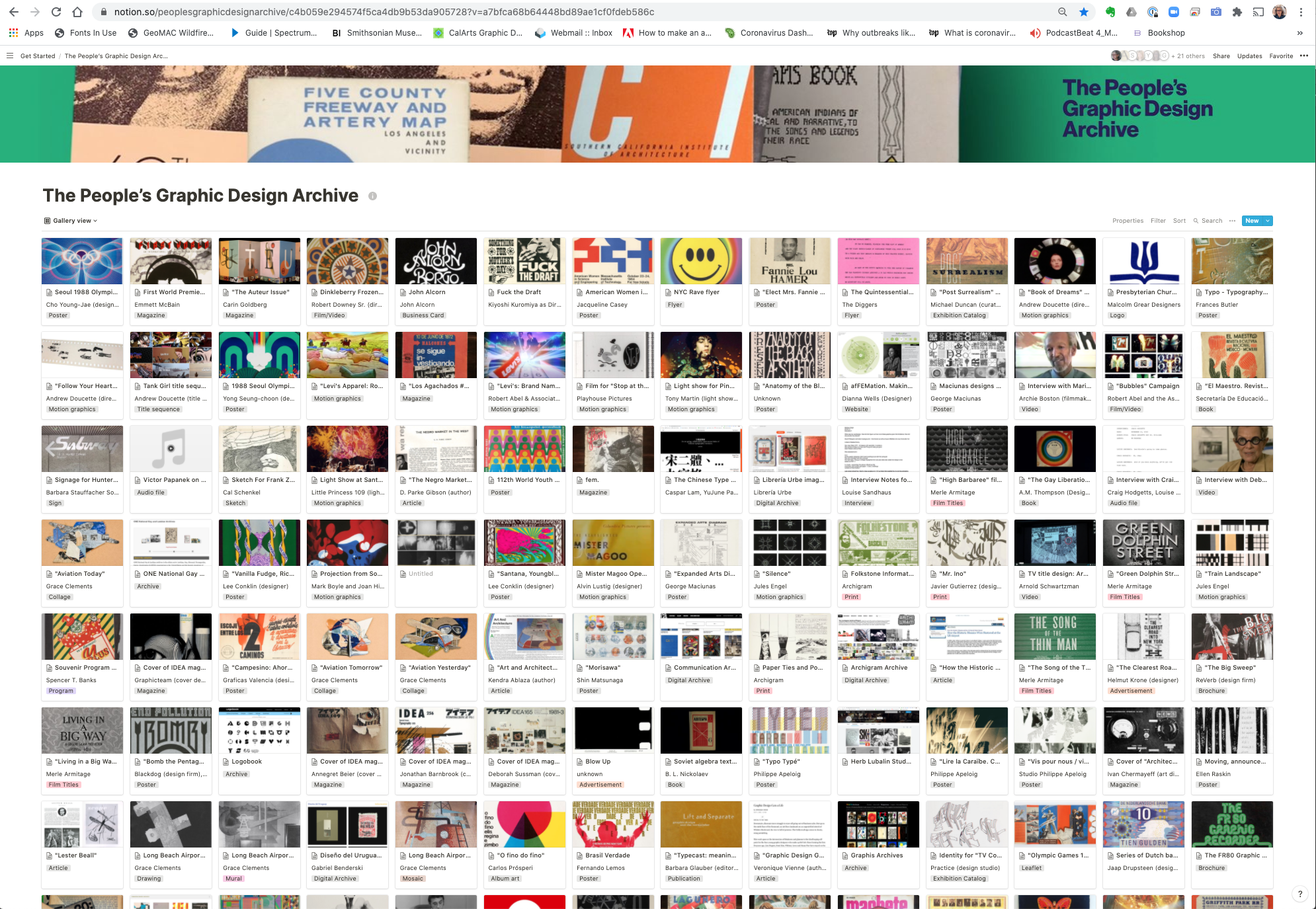
On December 11, 2017 the AIGA organized a confab of graphic design historians, critics, researchers and archivists to consider the direction of the field’s expanding yet narrow field. Graphic design history had been a patchwork of narratives involving certain schools and movements built around commercial advertising and publicity, book and periodical and typographic avant gardes which defined a taxonomy of styles, methods and philosophies. The founts of inspiration largely came from Europe and the United States through records mostly published in professional manuals, books and trade magazines. The principal practitioners were generally white males, although various non-mainstream cultures were sometimes covered in trade journals and exhibitions.
During the 1950s graphic design history gradually emerged as pedagogy and art museum curators began to collect graphic design ephemera and acquired papers and artifacts. Graphic design history books became accessible to wider audiences through a rise in classes, symposia and conferences. During the early 1980s graphic design history articles, surveys and monographs focused on ideas, methods, themes, disciplines and already acknowledged histories (the so-called canon). As the pedagogy developed the need for instructive materials, including books, journals and films and digital data bases have increased. But even with the upsurge of serious scholarship and amateur connoisseurship, graphic design history, like many cultural histories, has never been entirely inclusive. The nature of scholarship is discovery and inquiry, which requires effort, rigor, time and passion.
The AIGA meeting was organized to address novel approaches and the most original project, The People’s Graphic Design Archive, promised to redefine the scope of and correct the omissions in graphic design history. It has been in the development stage for a decade, but two weeks ago the PGDA platform was initially introduced to the education community. Using edited crowd-sourcing that explores and argues for under-represented artifacts and individual makers,the stewards of this ambitious venture are Louise Sandhaus, author, historian and designer, Briar Levit, filmmaker and designer, and Brockett Horne, Chair, historian and designer. On the occasion of the PGDA launch, I asked Sandhaus to explain the history and expected outcomes of this much needed project.
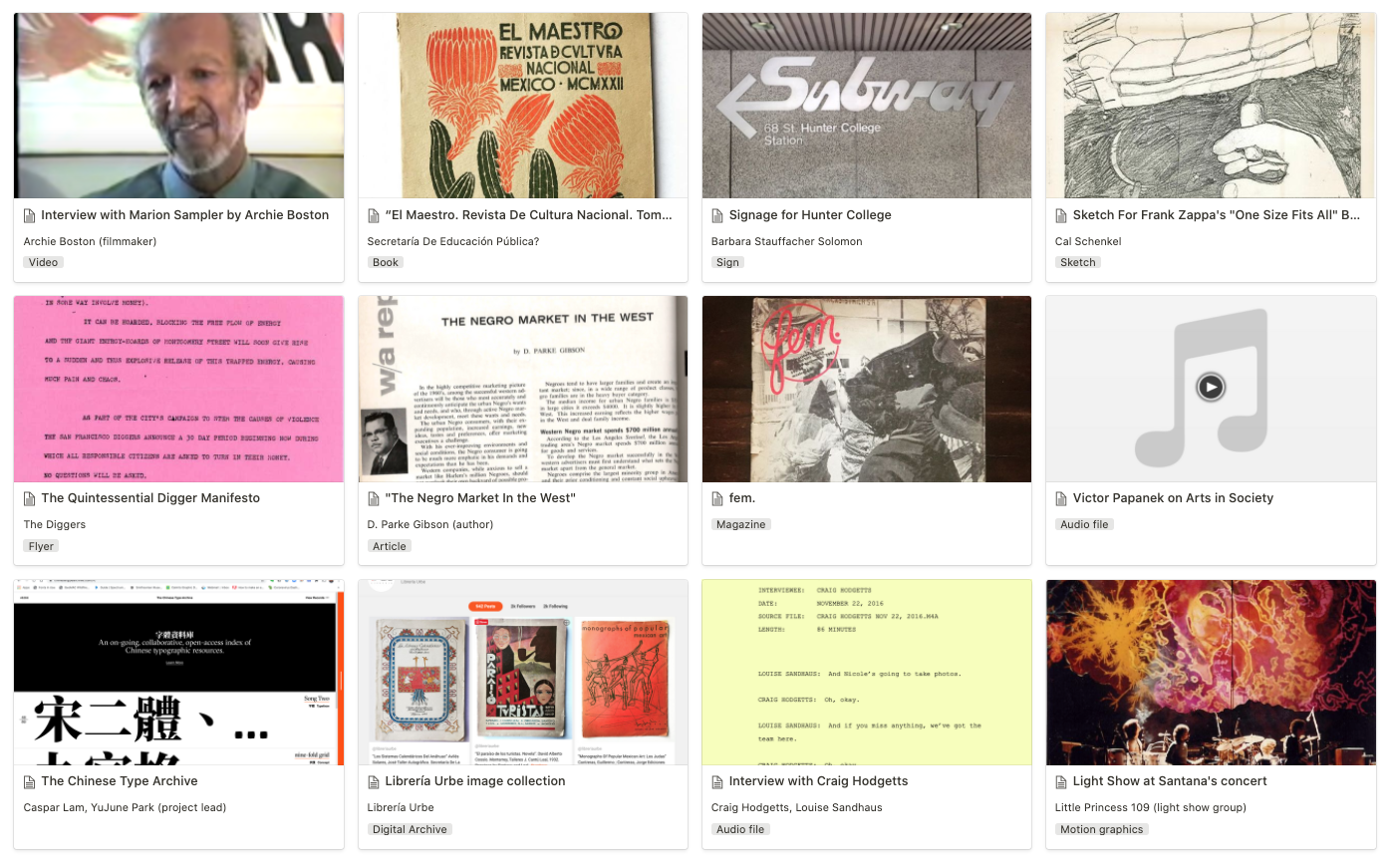
Steven Heller: I see The People's Graphic Design Archive as analogous to Story Corps for collecting personal narratives. I mean in so far as it is a crowd sourced project, open to all contributors and your proscribed limits are broad. in fact, broader than I had expected under the rubric of what is "graphic design." How did this idea come together?
Louise Sandhaus: It’s a circuitous tale! It starts with my 2014 book, Earthquakes, Mudslides, Fires & Riots: California and Graphic Design, 1936–1986. By the end of 10 years of research in which I came across so many designers and so much work to follow up on, I would have needed several lifetimes to accomplish that. When the book came out, I was proud of it but I knew that I’d just scratched the surface of what was out there and that there was a much more complex history of graphic design.
I also became aware that I was probably among a handful of researchers with the time and resources to delve into this infinity of material—stuff stashed in attics and basements, and all the stories about the lives and experiences of the people who had made this work—all of that would likely end up in dumpsters. I realized that some kind of emergency measure needed to happen so that at least there would be a record of this work. Even crappy photos, because better crappy photo documentation than no record at all. In doing the Earthquakes book, and even more so when Kat Catmur and I did the book A Colorful Life: Gere Kavanaugh, Designer, even poor documentation could fill us in on work that had been done or confirm a date or a client or the nature of a project. Records are crucial to understanding context as well as getting factual information. It’s easy to overlook the fact that history is a product of documentation. No records; no history. Crowd-sourcing and using technology seemed like the only way forward.
It was when the Los Angeles County Museum of Art (LACMA) announced that it was collecting graphic design that there was real impetus to make something happen to increase broader recognition and preservation. I wanted this institution to be aware of all the remarkable production that had happened in their own backyard, but the only way that was going to happen was through a huge effort to unearth and bring this work to light. That’s how the project was born, but it took years to propel the idea forward and there were many fits and starts.
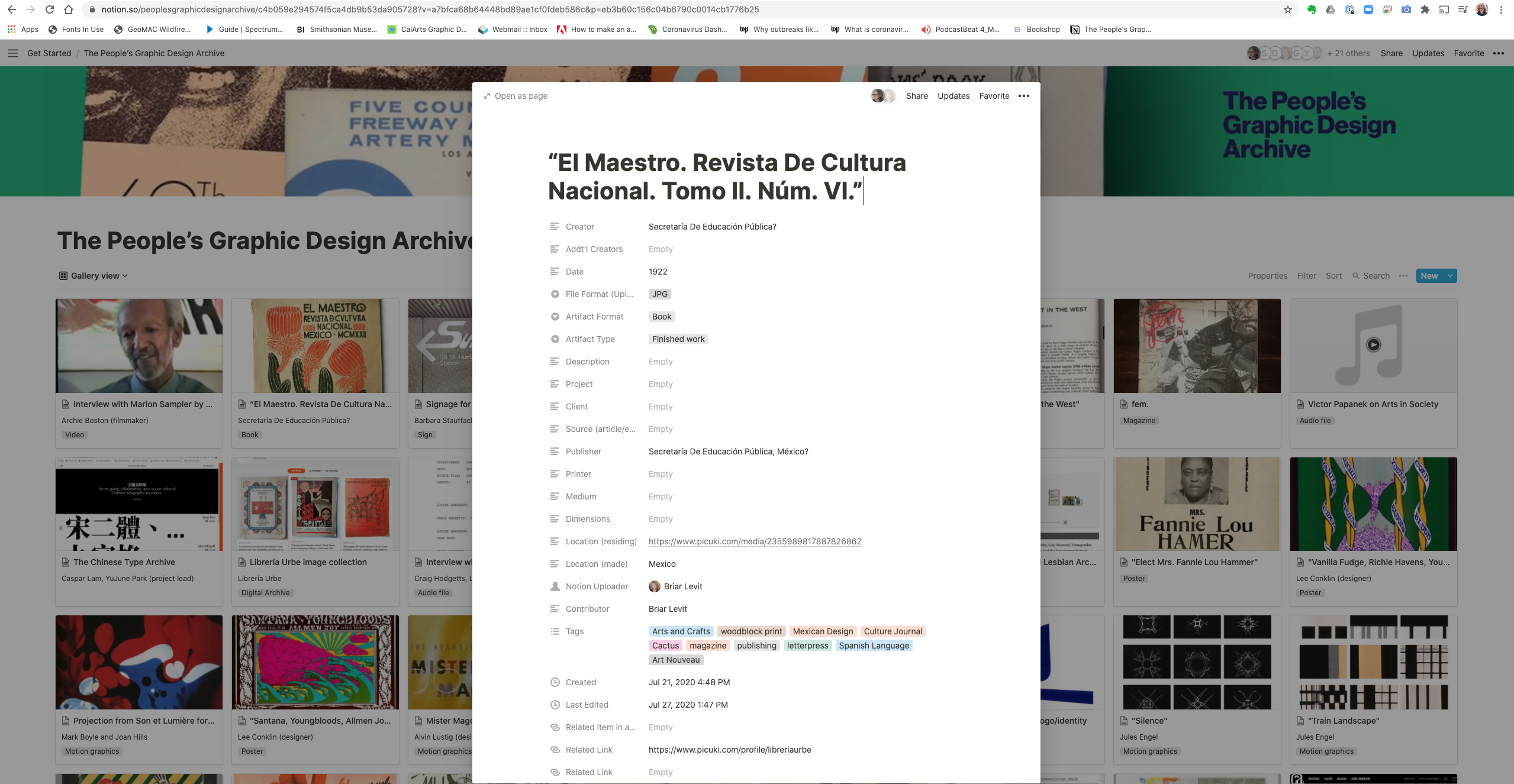
SH: Sounds to me like the turning point was realizing even in the datasphere there was a black hole.
LS: The turning point really happened last May. Inspired by the design history work Silas Munro was doing, I approached him about somehow working together. What quickly emerged was Design History Friday, a remote support and feedback meet-up for those doing graphic design history research or reconsidering how graphic design history is taught. It was through this group that Briar Levit and Brockett Horne stepped forward and are now project partners. Briar is a fireball of energy and propelled the effort leaps and bounds forward. Brockett has been at the ready no matter what help was needed and her eagle-eye was particularly handy in thinking through details and seeing blind-spots. And besides that, they’re so much fun to work with!
The other cosmic shift was the involvement of the Fonts in Use (FIU) team, Stephen Coles, Rob Meek, and Nick Sherman. There are two ways in which Fonts in Use team have been incredibly significant. First, I’d seen FIU but it didn’t register as a model for The People’s Graphic Design Archive in that it wouldn’t allow contributors to add content directly. Because contributions to FIU go through an editor I’d dismissed it. Later I understood the wisdom of having this very small threshold and it was then that the FIU platform became our model. Secondly, the team has agreed to be our developers for the platform. They’ve been incredibly generous advising us and are responsible in so many ways for getting us to the point we are now. What really got us to this moment of having a functional prototype was Nick Sherman urging us to get something out there—a prototype to make the project visible and to test our concept. The team suggested AirTable or Notion and from there we were off and running. I’m on my knees in gratitude to these guys.
SH: You’ve described your motivations. What are your inspirations?
LS: The project, as I described above, is partly the result of frustration and partly inspiration. The inspiration really goes back to Lorraine Wild’s "Historical Survey of Graphic Design" class at CalArts that I took as a student. She had an eye for the weird and wonderful—stuff you wouldn’t have found in any standard graphic design history course taught in the early 1990s. The class launched not only a recognition of a more expansive world of graphic design, but also taste for it.
The other inspiration is Brewster Kahle. I’ve been a groupie of his since he was with the Library of Congress thinking about how digitization would change the role of the library and access to knowledge. Brewster went on to found Archive.org and the WaybackMachine.org. His effort preserving cultural artifacts and digital history is the sun around which the PGDA is orbiting.
But generally speaking, the inspiration is all the momentum going on to rebuild graphic design history. There are so many educators, researchers, students, and motivated individuals who are exploding and expanding what belongs as part of our history.
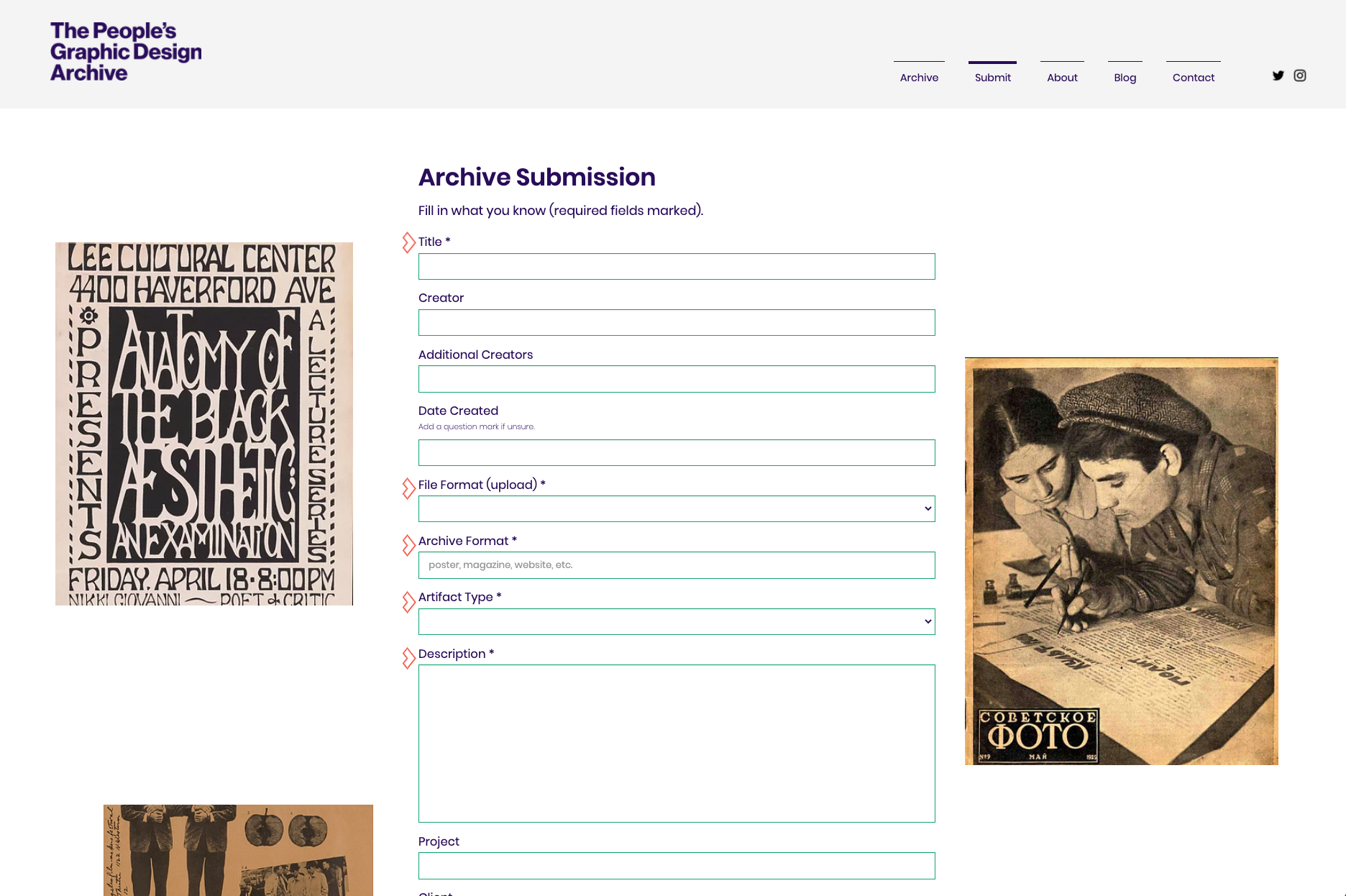
SH: Design archives are, shall I say, a growth area and ubiquitous these days. First, the cloud makes unlimited collection possible. Second, in general people are more conscious of their visual / graphic environment (which leads to a more focused interest in history). Third, building out the cannon is a priority for design educators, scholars and practitioners. What are your goals with this aptly named project?
LS: Our goal is for The People to decide what should be part of graphic design history; it’s about busting open pretty much any sort of gate-keeping. If you Google “graphic design history” the images that you’ll get are pretty homogeneous as you know—the same story keeps getting told about the same people. The representation of the historical trajectory from which graphic design today has evolved has been pretty pale (pun intended). We hope people take a look at what’s in The People’s Archive and any preconceived understanding of graphic design history will simply explode. But even more than that, and more importantly, the hope is that we see through the diversity of work and expression how values have been reflected, shaped, and contested. We hope that people will use this site for research and to develop and share a much broader range of historical material, interpretations, and stories. The PGDA has a political agenda, if that wasn’t recognizable from its name.
SH: How do you see The People’s Graphic Design Archive as advancing the recording, as well as changing or rewriting of graphic design history? Is your focus inclusion and diversity? Or something more layered and nuanced?
LS: Ultimately we see The Archive as rewriting history—creating a new image of history. It’s certainly intended to be expansive in terms of who is included; that’s been the intent since its formulation, but now there’s more urgency and for an expanded recognition of who and what matters. I think we’re going to be shocked by what knowledge is unearthed and how the field has played a role in systemic exclusion and how much history has been left out or unknown including individual practitioners, those who worked in collectives or as a team, as well as other contributors such as typographers, lettering artists, illustrators, printers.
Some of the material we hope to include may seem banal, but important. Things like forms, signs, and other bureaucratic materials that expand and inform our understanding of context and the forces that shape what and how things get made. I want to emphasize that the archive (or what you told me once was really a repository) holds all kinds of records, not just finished projects, but includes everything from finished projects to process, photos, letters, oral histories, anecdotes, published and unpublished articles, essays, and other supporting material in the form of all kinds of media including documents, videos, audio, as well as links to other relevant archives and websites.
SH: What are the criteria for inclusion in the archive? Are there on-limit and off-limit aspects to what you collect?
LS: I’m sure we’re going to learn along the way, but right now nothing is off-limits as long as someone considers it as belonging in a graphic design history repository—including that item is at least 10 years old, which is the threshold for “history” as we’ve defined it. Of course, the parameters as to what belongs to “graphic design” may be contested. And yes, there will be work that’s offensive. If we’re going to confront the past, we have to know what that past looked like. I think you know this better than anyone. We are not celebrating these representations and will have to make sure that they are not used by others for the intention of mockery or a malicious agenda. There have been several suggestions for ways to acknowledge these works that may be considered offensive or hurtful.
The point that seems important to make here is that while Briar, Brockett, and myself are stewarding the project for the moment, ultimately it belongs to the community and the community will need to decide.
SH: Must everything be annotated, so that the archive is not just a digital box of "stuff"? Or is it a place that invites research and questions?
LS: #notpinterest. We hope that contributions are annotated and we do have a few required pieces of information, but we recognize that filling in the data may take time and a collective effort. Our vision is that crowd-sourcing will also have a role in expanding information about individual items in the collection. Much like Wikipedia the community will add data as well as monitor disputed information and fix or flag it.
What’s vital is that contributors tag-tag-tag. It’s through tagging that the resources become the most valuable as these labels convey different relevancies. For example, the Day of the Dead title card designed by Deborah Sussman while working at the Eames Office, is tagged California, California design, Los Angeles, Eames, film title, Deborah Sussman, women in design, typography, modern, folk art, ornament, Mexico, Latin America, motion graphics, eclecticism, modernism and eclecticism, films by designers. To state the obvious, we hope this work can be found no matter what someone is searching for based on their interests. It could be “women designers” or “title design” or “films made by designers.”
Another aspect of #notpinterest is that it depends on repinning stuff that’s already “out there.” One aspect of the archive that’s vital—that we REALLY hope for— is for graphic design researchers to add what they’ve discovered. The interviews, photos, process, as well as finished projects that would otherwise fester in digital or physical file folders. The goal is preservation first and foremost; not just recirculating. Of course we hope that people will add works that may be hidden or unknown visible—including other archives— but we don’t need to see Milton Glaser’s Dylan poster here.
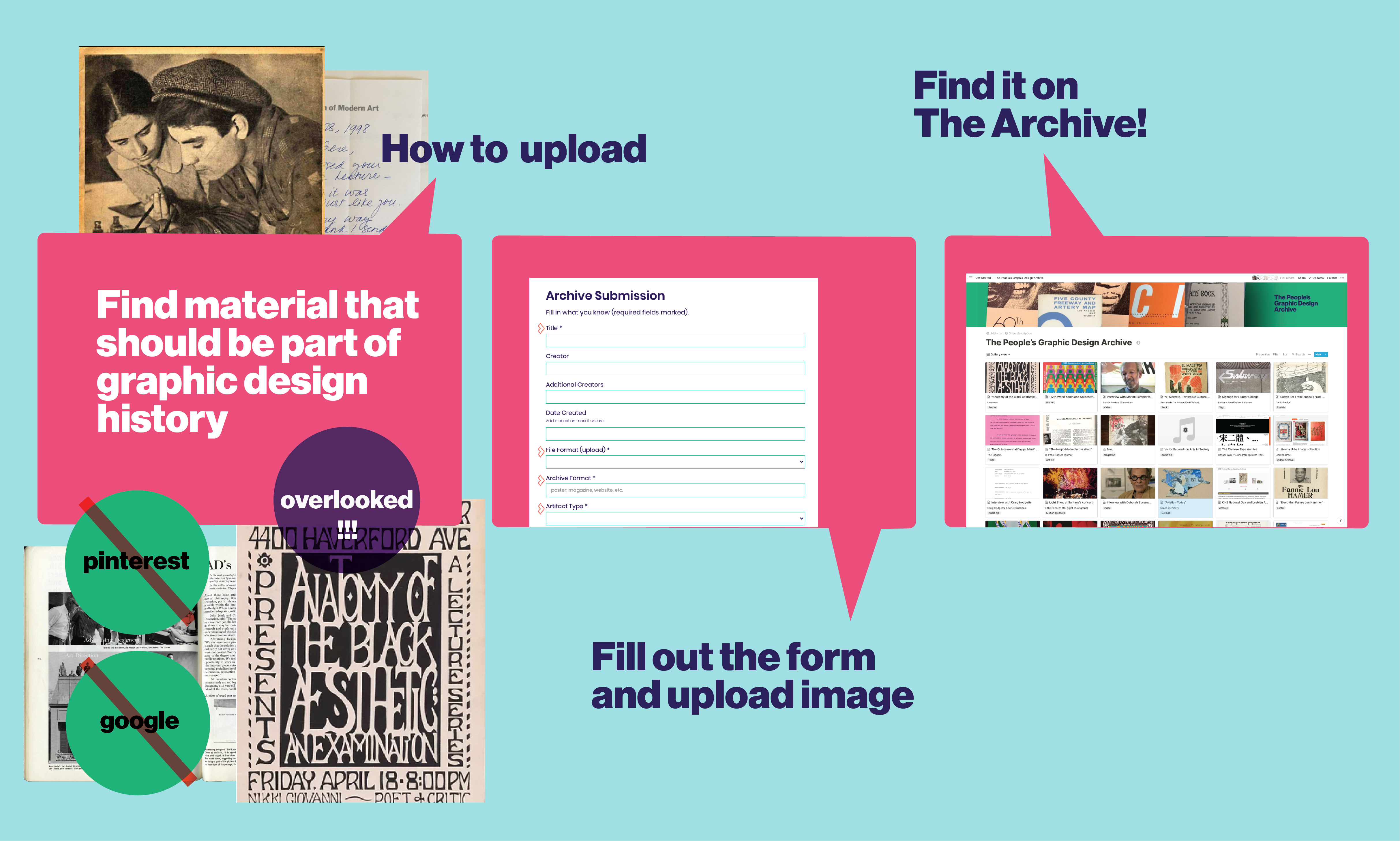
SH: The idea of a crowd sourced history was tried a decade or more ago at Cooper Union. Mostly it was filling in missing information or stories on materials that were already known to be graphic design? It did not get a lot of traction. How will The PGDA get that traction?
LS: It feels we’ve reached a tipping point for The People’s Archive. When the soft launch of the prototype site happened, we were overwhelmed by all the love. It feels as if there was pent up need and desire for this—hopefully enough of it to sustain the project. So, there is a sense of being on the other side of that tipping point. That moment came for me personally when Rich Hollant, someone I enormously respect and admire, posted to my Facebook announcement of The PGDA soft launch, “Please visit the site and imagine how it will feel when folks who have been pushed to the sides are brought together in a place of dignity and appreciation. I think that's called healing.” When I read this I felt sick with over-excitement. That the years that went into this were paying off.
But here’s what gives me confidence that this project takes full flight: Briar and Brockett. They’re relentless contributors to making this happen. I couldn’t imagine or ask for better partners.
The FIU team, Nick, Rob, and Stephen. They’ve guided us with such incredible wisdom about how to shape the project in realizable ways because they’ve successfully done what we’re trying to do. They bring the experience of having created and sustained the Fonts in Use site—a site that so many consider a necessary and valuable asset. They’re giving us the roadmap that a project of just this type and complexity requires.
We’re also working with the Microsoft Design, AI + Research team headed by Ana Arriola. They’ve been supporting us with their considerable experience and generosity on vital aspects of platform design and we’re now looking at how machine learning and AI can help make the platform even more robust for future iterations.
I want to mention what’s felt like an army of contributors—students, colleagues, and several summers of interns, the support of our institutions and of other institutions.
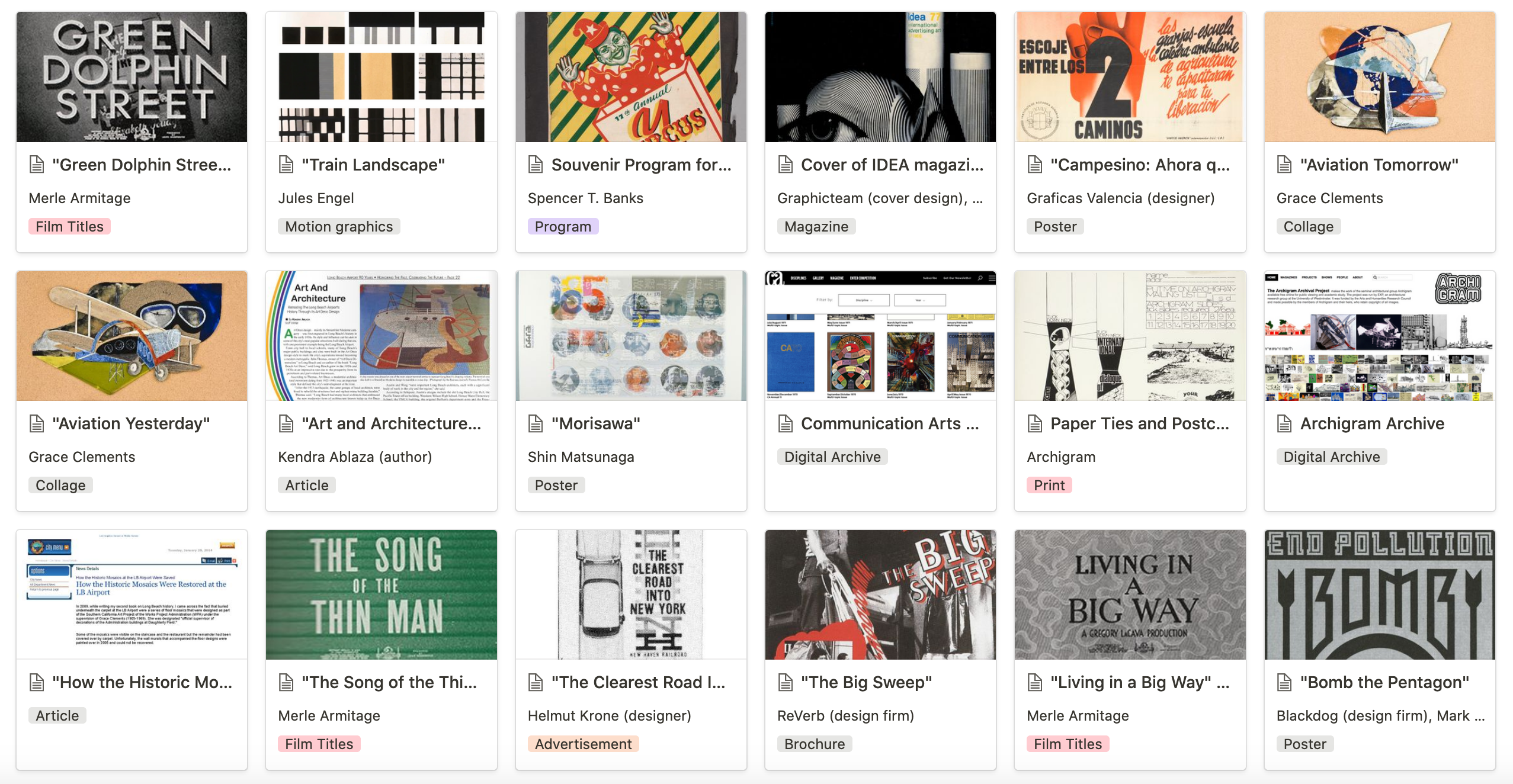
SH: This is very ambitious venture. Obviously, it is more than a single historian charting his or own path. When I began digging in attics and recording practitioners I could pretty much do it alone. What passed for history was very limited. As I said ambition, engagement and energy are essential.
LS: Of course, we’ll need to keep the project in the public eye and build a cohort of contributors and allies but it feels like we have the wind at our back regarding this.
We’ll need a partner—at least one. There will be a LOT of data that needs to be maintained in perpetuity. That’s not something we can do on our own. This may align with yet another reason why we feel that the People’s Archive has traction: The demand for more equitable and accountable institutions. Museums and archives recognize the need for radical new ways of equitably representing and engaging communities. The Archive seems to check so many boxes. The People’s Graphic Design Archive is also what collecting means in the 21st century—participatory, transparent, and without a gatekeeper. And it provides a campfire for broad conversation in that it represents the diversity of public visual culture.
SH: How will The Archive work? It’s obvious on the front end (i.e.participation by lots of people supplying lots of material). But what about the backend from platform to editorial needs?
LS: As I mentioned earlier, the teams who created (and run) Fonts in Use — specifically Rob Meek as the back-end developer and Nick Sherman as front-end designer, to use the terms loosely, will be developing the platform for The People’s Archive. We’ve connected the FIU team with the Microsoft team so that when the site is built there’s an awareness of being able to accommodate and adapt the platform to future generations of the site that will incorporate machine learning and AI.
The data fields that we’ve established to gather information about submitted items are ones that integrate with other digital archives so that The People’s Archives can “speak” with other archives. (We’ve had a number of archivists giving us feedback along the way.)
We’ve established Community Guidelines. The idea is to have a community group that maintains the flame of the site and oversees the Guidelines. There will be an editor who will essentially push the “upload” button. The is the one filter we have to ensure the integrity of the commons. This person will also probably help facilitate the blog where the community can share research and ideas.
If the Archive “works” then we’ll see new interpretations of the past, by new voices, as well as new forms of “writing” about history. While I love the Archive as a pantry, ultimately what matters is how all these new ingredients are used for new and tasty dishes!
By the way, copyright is something that we’re often asked about. We make explicit that we do not own or claim ownership to any of the material on the site. While we’re very supportive of liberal fair use, we do respect the intellectual property of others and ask the community to be respectful, responsible, and mindful.
SH: What do you need now that you have a very enticing prototype to make a go of it? How much in funding is enough?
LS: We’ll need around $65k to get it off the ground and around $25k annually to maintain it. The budget covers design and development as the major development cost but the start-up budget also includes marketing and promotion, web services, and maintenance for the first year.
For our annual operating budget, the expenditure for design and development diminishes but the other budgets increase somewhat. An important expense is for the editor. Again, this is the person who pushes the upload button. While the site is crowd-sourced and people will be a ble to directly add material, we want to ensure that all material meets the community guidelines.
This is our low bar budget. We also have a much more ambitious one in the wings. Heheh.
SH: What are the next steps?
LS: First need is to fundraise to get the platform built. We love Notion, but need the real thing in order to allow for true crowd-sourcing. Now that we have the prototype there’s something tangible to share with potential donors. We also need to simultaneously get the word out about the project, get others excited and involved so that they see this isn’t Louise, Brockett, and Briar’s project—it’s the community’s. We’re just the moms.
SH: In working on this since 2017, what have you learned that will make this even more incredible?
LS: The demand is there and there’s a lot of stuff out there. I’m hearing the most astounding examples of unimaginable items that people have stashed or have been collecting. They’ve been collecting it not because it’s pretty but because of how it’s meaningful. It’s the way in which artifacts are meaningful—the discovery of all those meanings that will be game changers in our understanding of graphic design’s significance. Finally there’s a platform that can make it all visible. I think we’re about to make history.
